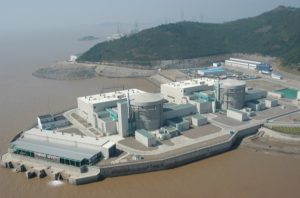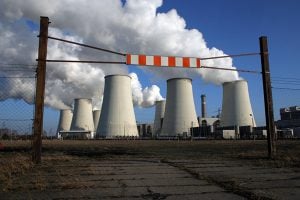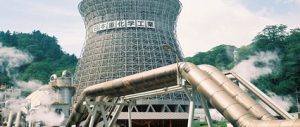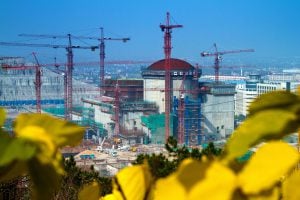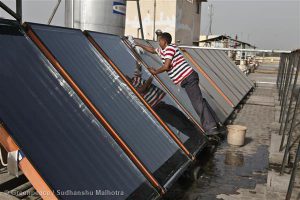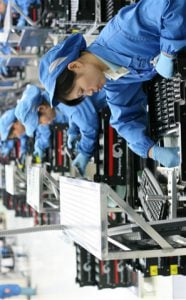The man in charge of cleaning up the wrecked Fukushima Daiichi nuclear power plant has admitted there is little cause for optimism while thousands of workers continue their battle to contain huge quantities of radioactive water.
The water problem is so severe that the plant’s operator, Tokyo Electric Power [Tepco], and its myriad partner firms have enlisted almost all of their 6,000 workers in the 2-trillion yen (US$17 billion) mission to bring it under control, almost four years after a deadly tsunami sparked a triple meltdown at the plant.
But Fukushima Daiichi’s manager, Akira Ono, said he believed workers had turned a corner in the long road towards decommissioning. “For three years we were dealing with the aftermath of the accident, so there was no way we could plan ahead.
“Even though I have no intention of being optimistic, it’s possible to say that we can now start to look forward,” Ono told the Guardian newspaper.
Each day about 400 tonnes of groundwater streams from hills behind the plant and into the basements of three stricken reactors, where it mixes with coolant water being used to prevent melted fuel from overheating and triggering another major accident.
Most of the contaminated water is pumped out and stored in tanks, but large quantities find their way to other parts of the site, including maintenance trenches connected to the sea.
So far, the plant has accumulated about 500,000 tonnes of contaminated water, which is being stored in more than 1,000 tanks occupying a large swath of the Fukushima Daiichi complex. By comparison, the partial meltdown at Three Mile Island in the US in 1979 produced 9,000 tonnes of toxic water.
“The contaminated water is the most pressing issue – there is no doubt about that,” Ono said. “Our efforts to address the problem are at their peak now. Though I cannot say exactly when, I hope things start getting better when the measures start taking effect.”
Previous versions of Tepco’s Alps [advanced liquid processing system] water treatment unit were plagued by technical hitches. In addition, tanks used to store the contaminated water were poorly assembled and suffered serious leaks, while plans to freeze water that has gathered in a trench near the damaged reactors are eight months behind schedule.
Work has begun on a 1.5km frozen barrier to prevent groundwater from reaching the reactor basements, but some experts, including Dale Klein, a former chairman of the US nuclear regulatory commission who now advises Tepco, have questioned its viability.
Despite doubts about its effectiveness, Tepco officials say the wall should be finished by next March, and completely frozen by May.
Along with the underground “ice wall”, the utility is pinning its hopes on a new version of its Alps water treatment system that can remove more than 60 radioactive elements.
Recent “hot testing” of the apparatus has been successful, raising hopes that a solution to the water problem may not be far off, said Shinichi Kawamura, head of risk communication at Fukushima Daiichi.
“This is a high-performance system because it uses only filters and absorbents to remove the contaminants,” Kawamura said. “The old system depended on chemical agents, which caused problems and created a lot more waste. We have confidence in this machinery.”
As Japan moves closer to a return to nuclear power after the local authorities on the southwestern island of Kyushu this month gave their approval for reactor restarts, Tepco can claim a significant victory in its efforts to improve safety at Fukushima Daiichi.
This month, workers completed the removal of the 1,331 spent fuel assemblies from a storage pool in reactor No 4, which was badly damaged in a hydrogen explosion after the March 2011 disaster. The removal of the unused fuel rods should be complete by the end of the year.
Some experts had warned of a potential catastrophe had the fuel rods collided or been damaged during the operation; Japan’s former ambassador to Switzerland, Mitsuhei Murata, went as far as claiming that “the fate of Japan and the whole world” depended on the successful removal of spent fuel from reactor No 4.
“This was a risky job, so when we removed the last fuel assembly we were delighted,” said Yuichi Kagami, who oversees fuel removal at the reactor. “This was a big step forward in the decommissioning process.”
The most dangerous and difficult jobs lie ahead, however. Tepco has yet to begin removing melted fuel from reactors 1, 2 and 3, where radiation levels are too high for humans to enter. Tepco engineers admit they do not know exactly where the damaged fuel is located.
Robots have been used to inspect debris inside reactor buildings, but none have been able to get anywhere near the melted fuel. The dangers posed by this unprecedented operation recently forced Tepco and the government to delay the planned start of fuel removal from reactor No 1 by five years, to 2025.
Decommissioning the entire plant is expected to take at least 40 years. The operation, including compensation for tens of thousands of people forced to evacuate their homes, will cost around 10 trillion yen (US$85 billion).
This article was first published by the Guardian and is republished here as part of the Guardian Environment Network
